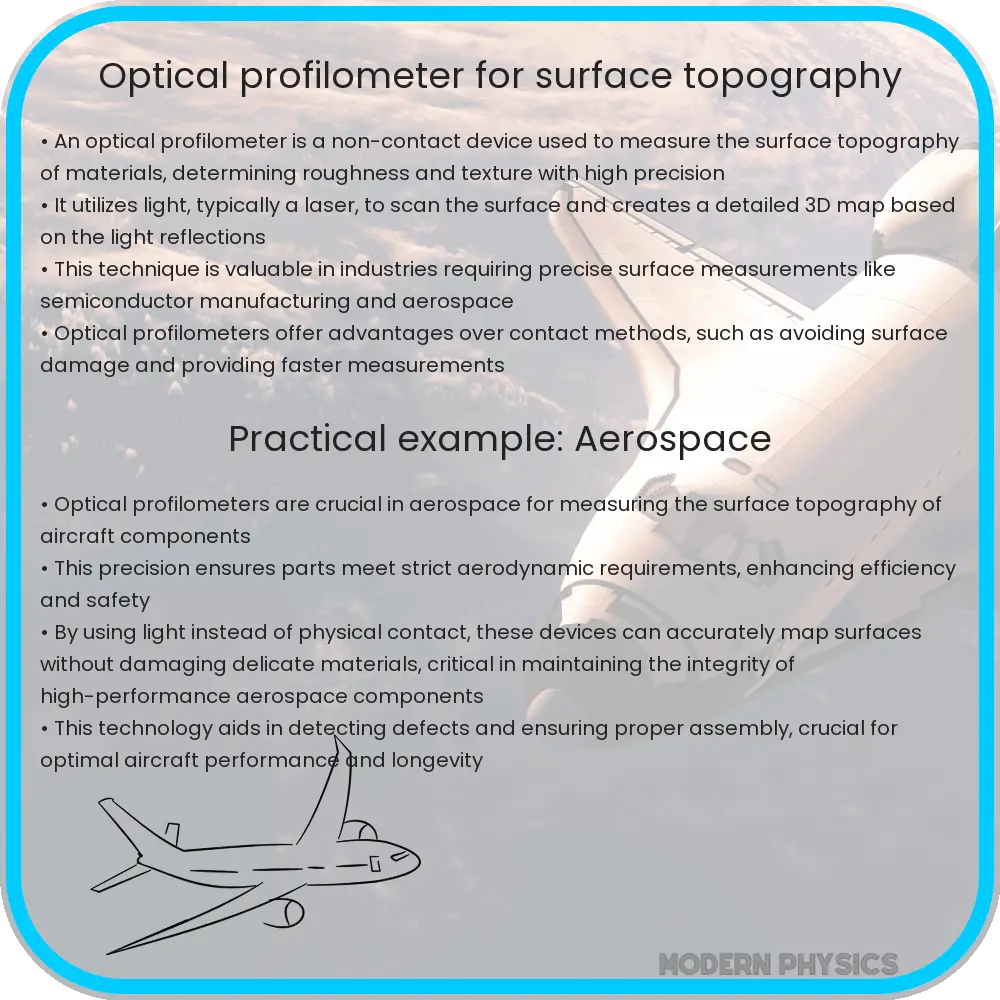Explore the precision, speed, and 3D imaging capabilities of optical profilometry, an essential tool for industries and research in surface measurement.

Introduction to Optical Profilometry
Optical profilometry is a cutting-edge technology used for surface measurement and characterization, offering unparalleled precision, speed, and the ability to produce 3D images of surfaces. This non-contact measuring technique employs light to measure the topography of a surface, making it ideal for a wide range of applications, from research and development to quality control in manufacturing processes.
Understanding the Precision of Optical Profilometers
The precision of optical profilometers is one of their most significant advantages. They can achieve nanometer-level accuracy in surface measurements, making them suitable for analyzing surface roughness, texture, and microstructures that are critical in various high-tech industries. This high degree of precision is achieved through sophisticated optical systems and algorithms that analyze the light reflected from the surface being measured.
The Speed Advantage
Optical profilometers are renowned for their speed. Unlike contact methods that physically touch the surface and are slower due to the need to protect delicate surfaces, optical profilometers can quickly scan surfaces without making contact. This rapid measurement capability is essential for industries where time is of the essence, enabling fast throughput without sacrificing accuracy.
3D Imaging Capabilities
The ability to create detailed 3D images of surfaces sets optical profilometers apart from traditional measurement techniques. Through various methods such as confocal microscopy, white light interferometry, and focus variation, these instruments can capture high-resolution three-dimensional surface profiles. This capability allows for a comprehensive analysis of surface features, including volume, area, height, and form measurements, providing invaluable data for surface engineering and analysis.
Applications Across Industries
Optical profilometry’s versatility makes it invaluable across a broad spectrum of industries. In semiconductor manufacturing, for instance, it’s used to inspect wafer surfaces for defects at the nanometer scale. The automotive industry relies on it to measure the precision of machined components. Biomedical applications include the analysis of tissue samples and the design of medical implants. The technology’s non-destructive nature and high-resolution imaging enhance product development and quality assurance processes across these sectors.
Enhancing Material Science and Research
Optical profilometry not only excels in industrial applications but also plays a pivotal role in advancing material science and research. By providing detailed surface analysis, it enables researchers to understand material behaviors, design new materials, and improve existing ones. This technology facilitates the study of wear patterns, corrosion processes, and the development of coatings that enhance material properties. Its ability to measure thin films and nanostructures is invaluable for developing new semiconductors, advanced ceramics, and composite materials.
Future Trends in Optical Profilometry
The future of optical profilometry looks promising with advancements in optical technology, software algorithms, and automation. Integration with artificial intelligence (AI) and machine learning (ML) is set to revolutionize how data is processed, enabling even more precise and faster surface analysis. Automation will further increase throughput and reduce human error, making optical profilometry an even more indispensable tool in quality control and research. Additionally, the ongoing miniaturization of devices and components in industries such as electronics and biotechnology demands the continuous evolution of measurement technologies like optical profilometry to meet these new challenges.
Choosing the Right Optical Profilometer
Selecting the appropriate optical profilometer depends on several factors, including the required precision, speed, and the specific applications it will be used for. It’s crucial to consider the material types, surface characteristics, and the level of detail needed in the 3D images. Manufacturers offer a range of models tailored to different industries and applications, ensuring that there is a solution available to meet virtually any surface measurement need.
Conclusion
Optical profilometry represents a significant advancement in surface measurement technology, offering unmatched precision, speed, and the ability to generate detailed 3D images. Its non-contact nature, combined with its versatility across various industries, makes it a valuable tool for quality control, research, and development. As technology advances, the capabilities of optical profilometers will continue to expand, opening new possibilities for material science, manufacturing processes, and product development. By embracing these advancements, industries can achieve greater accuracy, efficiency, and innovation in their operations, ensuring they remain competitive in an ever-evolving technological landscape.
